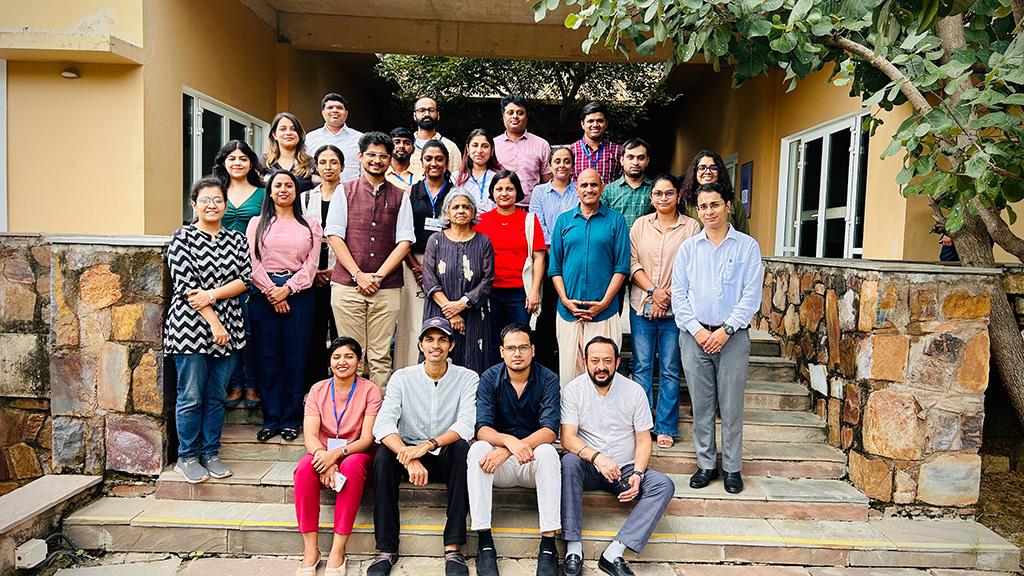Training Programme on Climate-Resilient Cities: Adaptive and Mitigative Approaches for a Warming Habitat
The Sustainable Habitat Programme conducted a four-day residential training programme on “Climate-Resilient Cities: Adaptive and Mitigative Approaches for a Warming Habitat” at the Anil Agarwal Environment Training Institute (AAETI) from September 9–12, 2025.
The programme brought together 21 participants. They included engineers, architects, urban planners from National Institute of Disaster Management, AMRUT-funded Centre of Urban Planning for Capacity Building in Punjab, Brihanmumbai Municipal Corporation, Hyderabad Metropolitan Development Authority (HMDA), and the Institute of Urban Designers India. Academicians from various built environment institutions such as Jamia Millia Islamia, Chitkara School of Planning and Architecture, Rishihood University, SJB School of Architecture & Planning, and Jawaharlal Nehru Technological University, Kakinada participated in the training as well. This diverse representation from around 16 cities and different climatic zones of India brought unique perspectives on the climate impact, risks and strategies being taken up in urban areas. This triggered rich discussions and made the entire programme quite engaging for all.
Day 1: Setting the Context
The programme began with an ice-breaking session where participants took part in a poll assessing their understanding of climate risks and vulnerabilities in cities, setting the tone for the discussions ahead. Mr. Rajneesh Sareen, Programme Director, Sustainable Habitat Programme, commenced the classroom sessions with an overview of the Climate Change and Vulnerabilities, explained how extreme weather events, such as floods, droughts, and heatwaves, are becoming more frequent and intense, posing new challenges for urban infrastructure. Ms. Mitashi Singh, Programme Manager, SHP, followed with a session on Understanding Urban Discomfort. She highlighted how built form, inadequate ventilation, high heat-absorbing surfaces, and lack of green cover amplify urban heat stress. addressing the growing risks of heat stress and the need for integrated planning. Post lunch Ms. Sayani Sen, Programme Officer, led a session on Flood Vulnerability in Urban Areas, explaining various component of vulnerability assement and different magnitude of exposure, followed by a hands-on session on Flood Vulnerability Assessment through Digital elevation model. The day concluded with asession on Environmentally Sensitive Zones, covering wetlands, forests, and biodiversity areasand their role in shaping resilient urban growth.
Day 2: Understanding Urban Heat and Cooling Strategies
Day two began with a quick recap of the previous sessions. Mr. Rajneesh Sareen opened with a session on Understanding a Landscape: Climate Vulnerabilities in Hills, explaining how slope instability, erratic rainfall, and ecological degradation increase risks in hill settlements. Participants then took part in a short contour analysis exercise to understand how topography influences flood resilience in cities. Ms. Mitashi Singh followed with a session on Assessing Heat Vulnerability in Urban Areas, introducing key dimensions of heat risk—exposure, sensitivity, and adaptive capacity. The discussion highlighted how vulnerable groups such as outdoor workers, slum dwellers, and women are disproportionately affected by rising temperatures and limited access to cooling.
Next, Mr. Sareen and the SHP team introduced the Cooling Master Plan framework, outlining how cities can reduce cooling demand through energy-efficient buildings, renewable integration, and district cooling systems. He also showcased how solar-assisted and waste-heat recovery systems can improve energy efficiency and resilience.Post-lunch, Ms. Sayani Sen led a hands-on session on Renewable Energy Integration, where participants explored ways to include solar, biomass, and other renewables in city energy planning. Later, Ms. Gargi Dwivedi conducted interactive sessions on Heat Contributors and Mitigation Strategies. Using simulation tools, participants studied how built form, materials, vegetation, and water bodies affect local microclimates. They then proposed neighbourhood-level retrofitting solutions—like cool roofs, shading devices, reflective surfaces, and increased tree cover—to reduce heat and improve comfort. The day ended with simulation-based heat mapping exercises, allowing participants to visualise temperature variations and assess the impact of design interventions in creating cooler, more livable urban spaces.
Day 3: Climate Finance, Heat Mapping, and Campus Learning
The day began with a recap of simulation results by Ms. Gargi Dwivedi, followed by a session on Thermally Efficient Roofs, highlighting materials and design strategies that reduce heat gain and improve energy efficiency. Ms.Mitashi Singh delivered an online session on Climate Finance, explaining key funding avenues such as international climate funds, state budgets, and public–private partnerships that can support low-carbon urban infrastructure. Ms. Sayani Sen then led hands-on exercises on Mapping Heat-Stressed Areas and Heat Sinks, using satellite imagery, LST, NDVI, and NDWI analyses to identify hotspots and cooling zones. These activities demonstrated how spatial mapping can inform climate adaptation and urban cooling strategies. The day concluded with a guided tour of AAETI by Mr. Sugeet Grover, showcasing the campus’s passive cooling design, dense vegetation, wastewater recycling, and resource-efficient systems that exemplify sustainable and climate-responsive architecture.
Day 4: Low-Carbon Materials and Cooling Innovations
The final day highlighted pathways to reduce carbon emissions in the built environment and promote sustainable construction practices. Mr. Sugeet Grover conducted sessions on Beyond Concrete: Low-Carbon Materials and Cooling Web: Low-Carbon Cooling Systems. He showcased material alternatives such as fly ash bricks, recycled aggregates, bamboo composites, and agro-based materials that lower embodied energy in construction. The sessions also covered decentralized and renewable-assisted cooling solutions for urban applications. Participants later presented their group exercise showcasing area-specific flood adaptation strategies for five selected wards of Delhi. The exercise involved analysing ward-level contours, natural drainage paths, and flood mitigation zones to identify suitable interventions for reducing local flood risk and improving water resilience. The training concluded with a closing ceremony led by the Habitat team.

Share this article